 Leading Blog | Posts by Month |
 Leading Blog | Posts by Month |
01.31.21

LeadershipNow 140: January 2021 Compilation
See more on
Posted by Michael McKinney at 12:59 AM
01.29.21

How to Reclaim Your Time and Live A Happier Life
TECHNOLOGY was supposed to give us more leisure time, but instead, it distracts us. We are pulled out of the present and into lists of things we feel we should be doing. Instead of getting time away from work, we take our work with us. It’s a trap to make us feel time poor. Time Smart by Ashley Whillans helps us to move from time poverty to time affluence. The key is how we think about time and money. Would you rather have less money and more time or work more for more money and have less time? We tend to overvalue money and undervalue time. Because we tend to spend as little money as possible, we rarely think of trading money for time. We make trade-offs between time and money all of the time. “All of these decisions powerfully shape the happiness we derive from moments, from days, from our entire lives.” Whillans identifies six traps that make us time poor. That is too many things to do and not enough time to do them. To become time smart, we need to recognize these time traps in our lives: technology (constant interruptions that fragment our time), a money/work focus (I’ll work hard now so I can afford more leisure time for a later that never comes), undervaluing time, busyness as status, aversion to idleness, and saying yes believing we’ll have more time later than we do now. How do we begin to turn this around? Whillans says to start with determining whether you are more money focused—willing to sacrifice time to have more money—or time focused—willing to sacrifice money to have more time. One is not better than the other but, “people who value money, and are in a position to be happier that way, still benefit from making time-related choices.” Our focus can change over time. The older we get, the more time becomes a major focus. We should make leisure time, but it should be the right kind. “Free time devoted to active leisure—activities like volunteering, socializing, and exercising—promote happiness far more than spending time engaged in passive leisure activities like watching TV, napping, or online shipping.” Fund time by outsourcing tasks or parts of tasks that you don’t like. Do less comparison shopping (we spend hours of time to save just a few dollars), or driving two miles out of your way to save ten cents on a gallon of gas. Account for your time. Even though research shows that “people who value time are happier, healthier, and more productive than those who value money over time, turning all of this into time-affluent habits is not easy to do let alone wrap our minds around it. Whillans offers eight strategies to become better at prioritizing time: 1. Address Your Why
Phone games before meetings / INSTEAD: Chat with colleague 2. Allow (or schedule) Slack Time
3. Know Your Calendar Mindset
4. Create Intentions
5. Implement Rewards and Punishments
6. Engineer Defaults
7. Recognize and Fight Mere Urgency
8. Make Leisure Leisurely
We need to take the long view of our lives. Whillans says, “You need to look ahead five to ten years and think about how big life choices will influence your time choices.” In a study of graduating college students, they found that “students who prioritized time were happier than those who prioritized money.” Time is not money. Money is time. And we all have only so much of it. It’s time to make time a priority before we run out of it. It’s night before it’s afternoon. December is here before it’s June. My goodness how time has flewn. How did it get so late so soon? — Dr. Seuss 
Posted by Michael McKinney at 12:03 AM
01.28.21

Leading Thoughts for January 28, 2021
IDEAS shared have the power to expand perspectives, change thinking, and move lives. Here are two ideas for the curious mind to engage with: Charles Sykes on victimization: “A formula for social gridlock: the irresistible search for someone or something to blame colliding with the unmovable unwillingness to accept responsibility. Now enshrined in law and jurisprudence, victimism is reshaping the fabric of society, including employment policies, criminal justice, education, urban politics, and, in an increasingly Orwellian emphasis on ‘sensitivity’ in language. A community of interdependent citizens has been displaced by a society of resentful, competing, and self-interested individuals who have dressed their private annoyances in the garb of victimism.” Source: Nation of Victims: The Decay of the American Character Tom Wheeler on how we are not alone in facing our challenges: “Limiting our horizons by ignoring our history denies us an essential appreciation: that the greatness of a people comes not from a retreat into halcyon memory but from the advances they make as they respond to newly created challenges.” Source: From Gutenberg to Google: The History of Our Future Look for these ideas every Thursday on the Leading Blog. Find more ideas on the LeadingThoughts index.
Posted by Michael McKinney at 07:39 AM
01.25.21

Leadership U: The Six Degrees of Leadership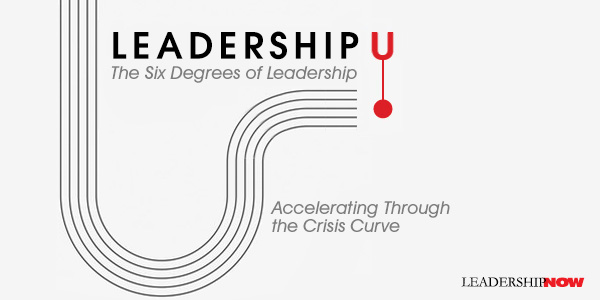
TO LEAD people from one place to another in good times and in challenging ones requires a framework like the one presented in Korn Ferry CEO Gary Burnison’s concise book, Leadership U: Accelerating Through the Crisis Curve. The framework is called, The Six Degrees of Leadership. These six degrees are mastered separately but work together in practice. Degree #1: Anticipate
Anticipating is 90% bottom-up and only 10% top-down. To anticipate, you need to make the hierarchy invisible. Take a total inventory across the organization as you listen for what people are thinking, feeling, fearing, and experiencing. Burnison says no matter the climate, the question is always, “What does this mean going forward?” Degree #2: Navigate
Impatience doesn’t get the job done. It inspires more fear than high performance, which can override critical thinking. Anybody who has gone into a skid on black ice can relate: your instinct is to slam on the brakes and jerk the wheel in the opposite direction. It takes a clear had to do the opposite—the counterintuitive—of steering into the skid to regain control. Degree #3: Communicate
When there is trust in what you say, there will be belief in what you do. That starts with modeling a “say/do” ratio of one-to-one. You do what you say and say what you mean. When you’re viewed as an authentic leader, people will not only trust your words and actions, they will also mirror what you say and do. Degree #4: Listen
What often can hold people back from giving honest feedback is the lack of perceived economic independence. Those over us control our resources. “Economic stability is the ultimate truth serum, and leaders need to recognize that.” As you listen, you need to distinguish between the urgent and the important. When a crisis hits, though, everything blurs as events and their implications constantly change. What’s important often becomes urgent, and the urgent becomes critical. You must delegate others to lead around a common purpose. Degree #5: Learn
The distance between your company and its competitors is not absolute; it’s relative. If you want to transform your organization, you must grow your organization through learning. Degree #6: Lead
In a world where so much has be reimagined, nobody has all the answers. This is not a time for individual heroism. It’s all about the team—and you need talented people around you. 
Posted by Michael McKinney at 07:46 AM
01.22.21

Embrace the Suck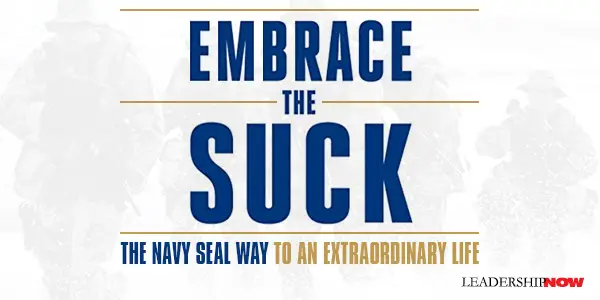
RESILIENCE is what carries us through life to reach our goals. Pain will always be with us, but if we can learn to lean into it and get comfortable with being uncomfortable, we can live a more fulfilling life. Resilience is what Brent Gleeson’s book, Embrace the Suck: The Navy SEAL Way to an Extraordinary Life is all about. He writes, “To avoid pain is to basically deny our potential. We can’t develop psychological resilience without experiencing emotional pain and suffering.” Resilience is about perspective and embracing reality. The most mentally and physically tough people I know constantly practice the fine art of building resilience—deliberately pounding away at the boundaries of their comfort zone in pursuit of their passions and causes greater than themselves. Simply put, they choose adversity over mediocrity and continue pushing forward despite the odds stacked against them. By strengthening our minds, we can overcome obstacles and pave the way to an intentional life. Gleeson provides us with several mental models to help us navigate misfortune, pain, and uncertainty. One simple but effective model Gleeson offers for this is the Five-Step Root Cause Analysis. When we understand cause and effect—the consequences of our behavior—we can grow and move forward. Observe, learn, and grow.
Gleeson uses the example of being laid off—the bad thing that happened to you. The High-Level Cause is at they had to downsize, keeping only the top performers. But as you dig deeper, focusing only on those issues you can control, like your actual or perceived underperformance, you can discover something actionable. Then ask what you did well and what you could work on and list them in step four. Then in step five, make specific goals that are concise, realistic, and time-bound, starting with an objective statement like “I will never lose another job for underperformance.” A useful tool for learning to identify and then control what you can control. This personal feedback loop will “place you in a constant state of course correction and improvement.” Of course, we need to be clear about our values. Your values help you know what winning looks like. “Essentially, any action or choice should clearly fit within your value lane markers. Deviation outside those markers typically ends in tragedy. You need to ask yourself what you are willing to do to live by those values and, even more importantly, what you are unwilling to do to avoid deviation.” Like removing temptations. When working towards our new goal, we have to remove anything that stands in the way of it. “Remove every opportunity for temptation and distraction—any obstacle or competing priority. Maintain total mission focus.” Develop self-control. Temptation is just a reality of life. Without it, there would be no such thing as willpower. Life will test you on a regular basis. So be prepared to ace the test!” And as Gleeson points out in chapter 7, chose wisely what you suffer for. “Life is a series of choices.” Successful Seals training students make it through because they “accept it as a means to a better end.” And he encourages, “If you stumble, find the root cause and move on. Don’t let yourself get wrapped up in guilt, anger, or frustration, because these emotions will only drag you further down and impede future progress.” Throughout the book, you will find many mental models with practical steps to move you forward. Models like Eight Failure Realities, Five Steps for Taming Temptation, Practicing the Things That Suck, Mastering Self-Discipline, and a model for Violent Execution, among others. How willing are you to embrace the suck? Go to war with yourself. 
Posted by Michael McKinney at 08:05 AM
01.21.21

Leading Thoughts for January 21, 2021
IDEAS shared have the power to expand perspectives, change thinking, and move lives. Here are two ideas for the curious mind to engage with: Brent Gleeson on resilience: “A growth mindset is the bedrock of resilience. With a growth mindset you know that skills and success come from hard work and dedication, and the status quo is never enough. People with this mindset are comfortable being uncomfortable. Transparent feedback is not just accepted but craved, and setbacks are just another bump in the road fueling the fire to push forward. ” Source: Embrace the Suck: The Navy SEAL Way to an Extraordinary Life Peter Boghossian and James Lindsay on the Unread Library Effect or how to help people understand that they are relying upon borrowed knowledge and moderate their views: “Explicitly invite explanations, ask for specifics, follow up with pointed questions that revolve around soliciting how someone knows the details, and continue to openly admit your own ignorance. In many conversations, the more ignorance you admit, the more readily your partner in the conversation will step in with an explanation to help you understand. And the more they attempt to explain, the more likely they are to realize the limits of their own knowledge. This strategy not only helps moderate strong views, it models openness, willingness to admit ignorance, and readiness to revise beliefs.” Source: How to Have Impossible Conversations: A Very Practical Guide Look for these ideas every Thursday on the Leading Blog. Find more ideas on the LeadingThoughts index.
Posted by Michael McKinney at 11:49 AM
01.18.21

How I Built This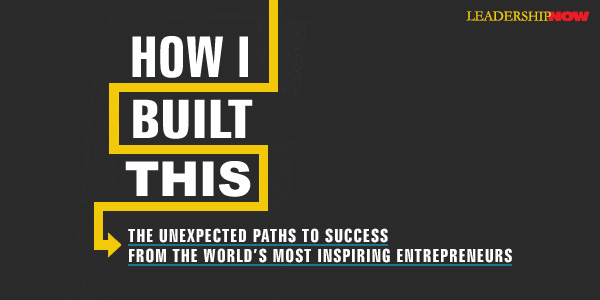
TAKING AN IDEA and building it into something tangible. That’s the entrepreneurial journey. Guy Raz interviews innovators, entrepreneurs, and idealists to create a narrative of their journey from spark to movement in a highly successful podcast on NPR and now a book entitled, How I Built This. How I Built This is an inspiring book that succeeds as a practical guide to the entrepreneurial journey. After interviewing hundreds of founders and CEOs, Raz says they are just like you and me—human. They all have sleepless nights and midnight terrors. Most of them, at some point, feel like imposters. They are not natural superheroes; they are all Clark Kents. The only difference between them and you, at this moment, is that when opportunity presented itself, they went into the phone booth and put on the cape. They took the leap. Raz has taken the lessons from the shows and structured them to “follow the path we took as we traced their entrepreneurial hero’s journeys from the call to found their businesses, through the tests and trials of their growth phases, and finally to their destination as mature, global brands we know today.” His goal is to “pull back the curtain on entrepreneurship, to shed light on the black box of entrepreneurial success, and provide an architecture for how to think creatively about building something, whether that’s an idea, a movement, or, of course, a business.” Embedded in these stories of entrepreneurs are business advice and life lessons. If the entrepreneurial journey does nothing else, it teaches you a lot about yourself. Here are some of those lessons:
The one thing Raz has learned from all of the people he has interviewed is this: Be kind; that kind leaders have kind companies; that kindness is a powerful tool; that kindness is free—it costs nothing!—and that return on investment for kindness is bigger than that for any financial investment an entrepreneur can make. As the stories in this book unfold, you will see that all entrepreneurs are good at dealing with rejection. The entrepreneurial journey is fill with “no.” It is their curiosity that often saved them and got them moving again. Starting a business is never easy, but if you have, or if you are thinking about doing it, you need to read this book. (And don’t forget to read the Afterword. It’s inspiring and helpful.) 
Posted by Michael McKinney at 07:45 AM
01.15.21

Culture Renovation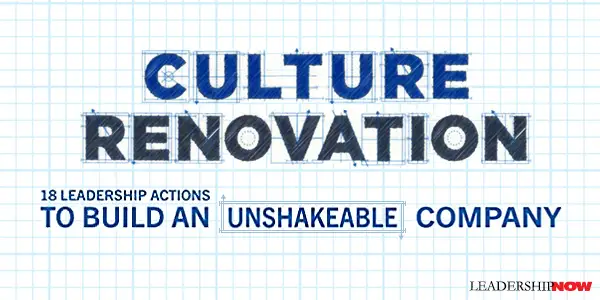
WE hear a lot about changing the culture. And the successful are more like renovations than they are like rebuilding the culture. Kevin Oakes advocates that mindset in Culture Renovation: 18 Leadership Actions to Build an Unshakeable Company Companies that effectively changed their cultures were successful because they were renovating what they had, not starting from scratch and completely rebuilding or transforming. Furthermore, he notes that the best time to renovate your culture is when all is well. Rarely do companies set out to change their culture when everything is calm and running smoothly, even though that is probably the best time to do it. Making the point that culture renovation begins at the top he replays the appointment of Satya Nadella as CEO of Microsoft after Steve Balmer in 2014. Cultural change at Microsoft began on day one. The key change was instilling a growth mindset. Microsoft’s culture had been rigid. Each employee had to prove to everyone that he or she was the smartest person in the room. Accountability—delivering on time and hitting numbers—trumped everything. Meetings were formal. If a senior leader wanted to tap the energy and creativity of someone lower down in the organization, she or he needed to invite that person’s boss, and so on. Hierarchy and pecking order had taken control, and spontaneity and creativity had suffered as a result. The culture change I wanted was actually rooted in the Microsoft I originally joined. The culture change I wanted was centered on exercising a growth mindset every day. The turnaround at Microsoft has been remarkable, and it started at the top. Oakes offers an 18-step culture change blueprint organized equally into three categories: Plan, Build, and Maintain. PLAN Step #1: Develop and Deploy a Comprehensive Listening Strategy. “Before an organization embarks on a culture renovation, it needs to first understand how the current culture is perceived. Too often, the senior team assumes they know what the culture represents. Too often, they are dead wrong.” Step #2: Figure Out What to Keep. Know what stays and what goes. Listen to employees (Step 1) is so important because “it not only illuminates what the culture is today, but it also helps determine the most positive and valued aspects of the company’s historical culture to carry forward.” Step #3: Set Your Cultural Path. “In the spirit of renovation, the new direction should acknowledge and embrace past successes, but set up the organization to forge new ground into an unknown future.” A carefully crafted purpose statement. Step #4: Define the Desired Behaviors. Once you have a short, pithy, and memorable purpose statement, the question is what behaviors will best support that statement. Step #5: Identify Influencers, Energizers, and Blockers. Know the informal organization using an organizational network analysis. Step #6: Determine How Progress Will Be Measured, Monitored, and Reported. “Ultimately, the reason for a culture renovation is to enable the organization to execute on its go-forward strategy. Because this change can sometimes take years, it’s important to define upfront what the indicators of a successful renovation should be, and to put in place mechanisms to monitor progress.” Oakes offers a number of common measures and methods. BUILD Step #7: Clearly Communicate That Change Is Coming. “To kick off a culture renovation, the CEO must articulate the purpose of the organization (whether new, old, or renovated), and that purpose must resonate with employees.” Step #8: Ferret Out Skeptics and Nonbelievers Early. This is the hardest step. “It’s the consistently de-energizing people that ultimately slow down or take down cultures. Ferret them out as early in the renovation as possible.” Step #9: Paint a Vision for the Future. The story matters. “73 percent of successful change efforts relied on stories.” A go-forward vision of the future. Most CEOs of corporate change failure attack previous leadership and focus their messages on the past. Step #10: Consciously Collaborate. Strong internal collaboration is important to drive change. The group must understand why they are coming together and what they are doing. Collaboration can go too far as in the case where “connectivity is through the roof because everyone believes they need to be consulted on decisions.” Step #11: Establish a Co-creation Mindset. “Though almost all successful culture change efforts begin top-down, it is critical to also get the buy-in of the workforce by creating a bottom-up (and middle-out) contribution mechanism.” Consider a Culture Hackathon. Ford “held a two-day event where employees worked in randomly selected teams to generate ideas to either fortify elements of the culture they loved or fix elements that weren’t serving the company well - #hackFORDculture. Step #12: Provide Training on the Desired Behaviors. Train leaders at all levels on the desired behaviors so that they can model them. “While leaders as teachers is one of the most effective ways to reinforce behaviors, it’s clear that successful culture change relies on overall leadership training across the organization.” MAINTAIN Step #13: Make Onboarding About Relationships Versus Red Tape. “If you want to maintain that culture renovation you worked so hard to put in place, you can start by improving your onboarding process.” The most overlooked aspect of onboarding: “Helping the new hire establish a network of trusted subject matter experts who will contribute to that person’s career success.” Step #14: Promote Those Who Best Represent the New. Behaviors that support the renovated culture should be rewarded. Showcase the “career advancement of individuals who best represent the new.” Step #15: Change Performance Management Practices. Most important is the “frequency and usefulness of feedback, clearly defining the business purpose of the performance process, and aligning it with the culture and values of the organization.” Step #16: Leverage Employee Affinity Groups. Interestingly, their research found that two-thirds of companies felt Employee Resource Groups were “more effective than other leadership development forums at developing leadership skills and competencies.” An ERGs primary benefit is to “raise awareness of the different groups of people that make up the workforce of most organizations.” Step #17: Increase the Focus on Talent Mobility. “During a culture renovation, one of the most successful talent initiatives an organization can focus on is rotating talent to strengthen ‘the pack’ and ensure the desired behaviors are exhibited throughout the organization.” Step #18: Don’t Underestimate the Value of External Sentiment. Use external feedback from places like Glassdoor, LinkedIn, and social media to monitor the progress of efforts to renovate your culture. Culture Renovation is less theory and more how to. You will find case studies and interviews with the participants of successful culture change. 
Posted by Michael McKinney at 07:35 AM
01.14.21

Leading Thoughts for January 14, 2021
IDEAS shared have the power to expand perspectives, change thinking, and move lives. Here are two ideas for the curious mind to engage with: Elaine Kamarck on presidential responsibility: “Despite of all the trappings of power—the big house on Pennsylvania Avenue, Camp David, Air Force One, never having to sit in a traffic jam (ever!)—the president is in charge of an entity over which he has fairly limited power. This is, of course, exactly the way the Founding Fathers wanted it. And yet, try telling that to the American public or to the world when something goes really wrong. As we have seen, large-scale governmental failure becomes presidential failure, whether the president likes it or not.” Source: Why Presidents Fail And How They Can Succeed Again Brad Stulberg and Steve Magnes on how to be passionate: “Mindfully living with passion starts with realizing that passion in and of itself doesn’t start off as either good or bad; it just is—a powerful emotion rooted in our biology and psychology. It’s not something we magically find, but something that we develop by following our interests and incrementally devoting more of our time and energy to them. The next step to mindfully living with passion is to become aware of its dark side. Only by understanding the pitfalls of obsessive and fear-driven passion—and taking deliberate steps to avoid them—does passion gain the potential to be productive. But avoiding pitfalls is not enough. An equal challenge is bucking current trends that favor instant gratification and instead actively adopting the mastery mind-set: maintaining drive from within; focusing on the process over results; not worrying about being the best but worrying about being the best at getting better; embracing acute failure for chronic gains; practicing patience; and paying full attention to our pursuits.” Look for these ideas every Thursday on the Leading Blog. Find more ideas on the LeadingThoughts index.
Posted by Michael McKinney at 12:00 PM
01.12.21

Leading Thoughts: Pass Them On
BRITISH statesman Benjamin Disraeli said, “The wisdom of the wise and the experience of ages may be preserved by quotation.” The ideas of others have the power to slow us down and consider perspectives beyond our own. Left alone, our thoughts become too narrow—too vulnerable to blind spots. This learning process may deepen our own thoughts, give us concepts to build on, and start great conversations. It’s also good to know that we are not alone and that others have lived through the same things that we now experience. We share two ideas every Thursday on the Leading Blog or sign up for our newsletter. Read them and pass them on!
Posted by Michael McKinney at 09:56 AM
01.11.21

It’s Time to Focus on Projects, Not Ideas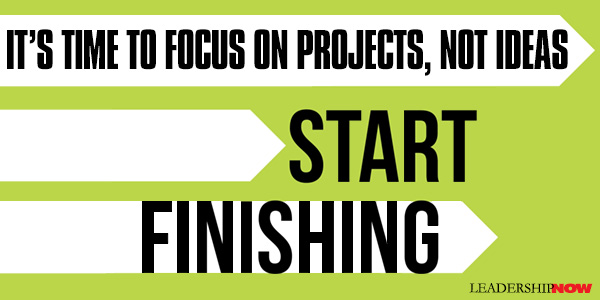
WE get distracted from what matters to us by our personal projects. Charlie Gilkey says in Start Finishing that a project is “anything that takes time, energy, and attention to complete.” There are projects that keep us busy, and then there are projects that help us thrive—get us to the next level. To get to the place where our soul longs to be, we’re going to have to convert our ideas into doable projects at the same time that we’re going have to get real about all the projects we are doing. The problem isn’t that we’re lazy or incapable—it’s just that we’re not doing the work that’s going to enable us to thrive. To get moving, we will need to find a place in our schedule for our best projects—the ones that make us thrive. The reality of finite time means we have to choose what is most important to us here and now. To make that happen, we need intention, awareness of ourselves in relation to our work, boundaries, the courage to move forward, and discipline. (IABCD if you are into that) “Our innate talent, creativity, and drive combined with discipline are what make us forces of nature.” There are consequences to not doing our best work. We wither, and we begin to suffer from creative constipation. Creative constipation is exactly what it sounds like. We take in ideas and inspiration that get converted into aspirations, goals, and projects, and at a certain point, if we’re not pushing them out in the form of finished projects, they start to back up on us. Gilkey covers how to make space for your project and the obstacles that get in the way of that and how to work your plan. Start finishing today. 
Posted by Michael McKinney at 08:16 AM
01.08.21

Eat, Sleep, Innovate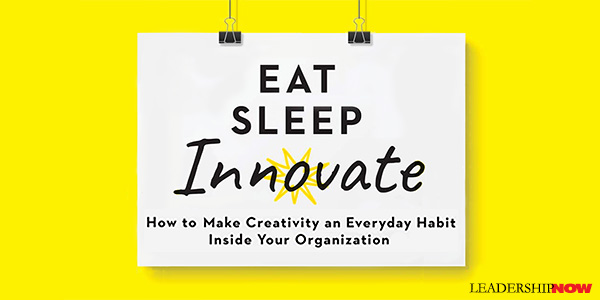
THE potential for innovation exists within our organizations. The problem is the culture doesn’t support it. Our organizational cultures tend to prioritize today over tomorrow. How do you make innovation as natural as eating and sleeping? Just something you do; part of your organizational culture? The authors of Eat, Sleep, Innovate—Scott Anthony, Paul Cobban, Natalie Painchaud, and Andy Parker—contend that the solution “requires focusing people’s daily habits through a series of interventions, and then ensuring that the new habits stick and scale.” We have to change the culture. And that doesn’t begin by copying the relics of highly innovative companies. We must deal with the source of the problem so that innovation and the manifestations of it arise organically from the culture of the organization. Their definition of innovation is “something different that creates value.” That’s distinct from invention. A light bulb is just a light bulb until it creates value. “Until you have turned a spark of creativity into revenues, profits, or improved performance, in our eyes, you have not innovated.” What does the organizational culture need to support?
What holds us back is fear and inertia that often the outcome of our successes. This inertia becomes the shadow strategy that is ingrained in our culture. It undermines anything we might say or attempt to do otherwise. “The shadow strategy quietly tugs and budges a company down a path of perpetuation, even if circumstances demand something drastically different.” And that kills innovation. The antidote to all of this is to break old habits and form new ones—and in effect, change the culture. To this end, a team at Innosight began collecting examples of interventions that promoted better innovation habits. They gave this collection the acronym: BEAN or: Behavior Enablers: Direct ways to encourage and enable behavior change
In Eat, Sleep, Innovate, they list 101 BEANs and cover, in detail, over 20 to help you design BEANs specific to your organization. There are six key ingredients to a successful BEAN:
BEANs encourage behaviors that build culture. Build a culture in your organization where innovation is the natural result. A place where people can bring their best to the assets of the organization and create something new that has value and impact. BEANs help to “shrink the challenge” into “micro shifts of change.” 
Posted by Michael McKinney at 07:10 AM
01.07.21

Leading Thoughts for January 7, 2021
IDEAS shared have the power to expand perspectives, change thinking, and move lives. Here are two ideas for the curious mind to engage with: Geoff Colvin on self-knowledge: “The best performers observe themselves closely. They are in effect able to step outside themselves, monitor what is happening in their own minds, and ask how it’s going. Researchers call this metacognition—knowledge about your own knowledge, thinking about your own thinking. Top performers do this much more systematically than others do; it’s an established part of their routine.” Source: Talent Is Overrated Charlie Munger on turning yourself into a learning machine: “I constantly see people rise in life who are not the smartest, sometimes not even the most diligent, but they are learning machines. They go to bed every night a little wiser than when they got up and boy does that help—particularly when you have a long run ahead of you.” Source: University of Southern California Law School Commencement Speech, May 13, 2007 Look for these ideas every Thursday on the Leading Blog. Find more ideas on the LeadingThoughts index.
Posted by Michael McKinney at 07:46 AM
01.04.21

Teams That Work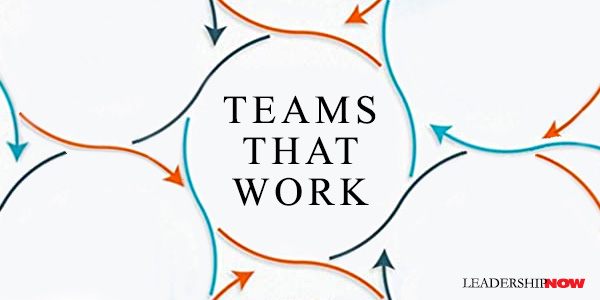
NOT every problem can be solved with a team. But when a team is called for, it is important to get it right. Teams That Work by Scott Tannenbaum and Eduardo Salas is a comprehensive look at teams and the drivers of their effectiveness—long term. Fairweather teams that crumble when things get tough or can’t recover from setbacks quickly are not effective teams. The authors say three components characterize effective teams: Sustained Performance (are able to generate positive results over time), Team Resilience (can work through challenges and can quickly bounce back from adversity), and Vitality (can maintain the energy, vibrancy, and resources needed for future success). Before addressing the seven drivers of team effectiveness, they point out that all teams are not the same. And this is important to consider because helping your team succeed depends on the nature of your team. They highlight five team distinctions and place each on a continuum from low to high: Reliance. Membership Stability, Task Consistency, Proximity, and Similarity. For example, the Reliance Continuum:
For teams that fall toward the far-left end of the continuum, sometimes all that is needed from a team perspective is for members to be civil with one another and not get in each other’s way. Perhaps all the team leader needs to do is provide individual feedback when deviant behavior emerges and occasionally host a social event, so team members see each other as real people. But for teams where team members must rely on one another a bit more, they need more than just being civil. They need to be able to pass the baton, know the planned plays, or adjust to one another on the fly. Teamwork and seven drivers become increasingly critical as we move from left to right on the continuum. Where is your team on these five continuums? The authors then get into the seven drivers of team effectiveness that consistently make a difference.
Capability Fundamental question: Do we have the right people with the right mix of knowledge, skills, and other attributes? If your team does have the necessary competencies, little will be accomplished. Consider both task-related capabilities and team-related capabilities. Team related capabilities include giving/receiving feedback, communicating, conflict resolution, leadership and interpersonal skills, and understanding how teams work. Communication Fundamental question: Do team members communicate effectively with each other and with people outside the team? Quality is more important than quantity, and a breakdown in communication makes the team vulnerable, especially in crisis situations. “Quality communication means sharing useful information clearly, accurately, and on time to the right people.” What drives team effectiveness is communicating unique information and knowledge that others may not possess or fully understand. That builds shared awareness among team members. Unique information can be related to an area of expertise, the status of a situation, or an action that is needed. It doesn’t need to be complex or highfalutin. Cognition Fundamental question: Do team members possess a shared understanding about key factors such as priorities, roles, and vision? When a team has conflicting or unreconciled points of view on priorities, roles, or how to handle certain situations, it can adversely affect to coordinate and perform effectively. In contrast, when a team possesses what psychologists call “shared mental models,” it often results in better performance. Another way to think about cognition is whether your team members are all “on the same page.” Conditions Fundamental question: Is the context in which the team operates favorable for performing effectively (e.g., ample resources, supportive culture)? Positive work environments create positive outcomes. There are some things that can’t be changed in an organization to accommodate the team. In that case, the team should learn to work around it. “It is helpful to think about conditions as operating on two levels: the broader organizational or business unit level and the local, team-specific level.” What is the situational strength of the environment? “Some situations are so strong they essentially mandate behavior, others only offer hints or ‘nudges’ about what to do, and weak situations may offer no clues about expected behaviors.” Organizational policies and practices, including performance management and compensation practices, create expectations about teamwork. The climate in which the team is embedded also matters. Coordination Fundamental question: Are team members exhibiting the necessary teamwork behaviors for team success? Coordination is about behaviors, not attitudes, and is at the heart of teamwork. Behaviors matter. The forms of coordination that matter the most are: maintaining situation awareness, providing back-up and support, learning and adapting, and managing team emotions and conflict. Coordination is more difficult when team membership is frequently changing, task requirements are dynamic, people work in different locations, or team members have diverse capabilities and perspectives. Cooperation Fundamental question: Do team members possess the right beliefs and attitudes about their team? Cooperation emerges from the other six drivers. Cooperation develops over time and is dynamic. “Cooperation isn’t like a skill or personality trait that you take with you from team to team. And it isn’t about your general attitude towards teamwork, but rather how you currently think and feel about this team.” Four forms of cooperation are essential: trust, psychological safety, collective efficacy, and cohesion. Coaching Fundamental question: Does the leader and/or team members demonstrate the necessary leadership behaviors? Coaching is not just for the team leader but is more of an all-in driver. Others on the team can step in and help with these functions. There are seven essential leadership functions: Task-focused:
Team-focused:
Team and task-focused:
People in power tend to self-anchor. That is, they tend to think and feel the same way they do. When in power, we have a harder time reading other’s emotions. We filter other’s opinions and thinking through our own opinions and thoughts and create false assumptions. “And, due to self-anchoring bias, our natural inclination can be to assume we are ‘reading the audience,’ when in reality, we are merely reading ourselves.” What I have presented here is just a brief overview of the material they present. You will find in Teams That Work practical so-what-now tips and how you can use this knowledge whether you are a team leader, team member, consultant, or a senior organizational leader of teams. Unless you work in a vacuum, this book will provide many insights for you. 
Posted by Michael McKinney at 03:09 PM
01.01.21

First Look: Leadership Books for January 2021Here's a look at some of the best leadership books to be released in January 2021. Don't miss out on other great new and future releases not listed here.
A global security expert draws on psychological insights to help you master the art of social engineering—human hacking. Make friends, influence people, and leave them feeling better for having met you by being more empathetic, generous, and kind. Christopher Hadnagy shows you how to use social engineering as a force for good—to help you regain your confidence and control. Human Hacking provides tools that will help you establish rapport with strangers, use body language and verbal cues to your advantage, steer conversations and influence other’s decisions, and protect yourself from manipulators. Ultimately, you’ll become far more self-aware about how you’re presenting yourself—and able to use it to improve your life.
In Rebel Ideas, Syed argues that our brainpower as individuals isn't enough. To tackle problems from climate change to economic decline, we'll need to employ the power of "cognitive diversity." Drawing on psychology, genetics, and beyond, Syed uses real-world scenarios including the failings of the CIA before 9/11 and a communication disaster at the peak of Mount Everest to introduce us to the true power of thinking differently. Rebel Ideas will strengthen any kind of team, while including advice on how, as individuals, we can embrace the potential of an "outsider mind-set" as our greatest asset.
It’s undeniable that we’re entering a new era of remote work. While many leaders seek to run business as usual, why settle for the usual when remote teams allow us to work even better? The research shows that employees are more productive and engaged when they have the freedom to work from anywhere. Which means leaders need the skills to lead from anywhere. In this meticulously researched, refreshingly practical book, top business thought leader David Burkus provides managers with the field guide to leading remotely, packed with everyday examples and illuminating insights.
Even before the coronavirus hit, remote work was growing at nearly 30 percent per year, and now it's just a fact of life. There are many millions of people who once worked at a central location every day who now find themselves facing an entirely new way of working. Written by the founders of the Remote Leadership Institute, this book is the most authoritative single resource for helping remote workers get work done effectively, build relationships that are both productive and satisfying, and maintain a career trajectory when they are not in constant close contact with their leader, coworkers, or the organization in general. The Long-Distance Teammate tackles three important issues: navigating the personal and interpersonal, growing the skills to be productive, and communicating effectively--all from a distance.
We see poverty, homelessness, violence, mental illness, corruption, and the breakdown of the family, and we think, Why doesn’t somebody do something? The institutions we’ve depended on aren’t making the world a better place the way we thought they could and should. So now it’s up to us. The good news is, YOU can change your world. In this book, John Maxwell and Rob Hoskins guide you through the entire process. These two leaders have been making a positive impact for decades, transforming millions of lives, communities, and businesses around the world with a sense of mission and regard for human dignity. And whether you influence only one other person or you’re the leader of a large organization, you too can bring about positive, lasting change.
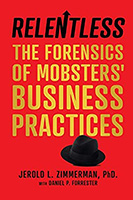 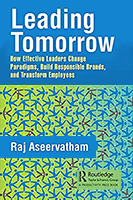 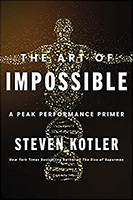
 Build your leadership library with these specials on over 28 titles. All titles are at least 40% off the list price and are available only in limited quantities. “Compare the difference between the life of a man who does no reading and that of a man who does. The man who has not the habit of reading is imprisoned in his immediate world, in respect to time and space. His life falls into a set routine; he is limited to contact and conversation with a few friends and acquaintances, and he sees only what happens in his immediate neighborhood. From this prison there is no escape.” — Lin Yutang, The Importance of Living
Posted by Michael McKinney at 12:02 AM
|
BUILD YOUR KNOWLEDGE


How to Do Your Start-Up Right STRAIGHT TALK FOR START-UPS 
Grow Your Leadership Skills NEW AND UPCOMING LEADERSHIP BOOKS 
Leadership Minute BITE-SIZE CONCEPTS YOU CAN CHEW ON 
Classic Leadership Books BOOKS TO READ BEFORE YOU LEAD |
|